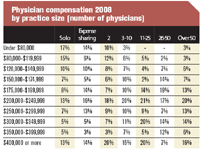2009 earnings survey: How do you compare?
A rough year for the U.S. economy had little negative impact on the income of physicians, according to the results of Medical Economics' 2009 Exclusive Survey.
A rough year for the US economy had little negative impact on the income of physicians, according to the results of Medical Economics' 2009 Exclusive Survey. (For details about survey methodology and basic demographic data on respondents, go to http://memag.com/2009survey/). As the recession took hold and third-party payers tamped down on reimbursement, physician income scarcely budged from 2007 to 2008.
According to the survey, which was administered in April and May to more than 100,000 office-based MDs and DOs in more than 16 specialties, median earnings for family physicians, internists, general practitioners, pediatricians, and ob/gyns remained roughly the same in 2008 as they were in 2007. Among them, ob/gyns were the top earners, posting a median income of $237,500.
Pediatricians averaged $187,500, followed by FPs, GPs, and internists at $162,500.

"I have had more calls in 2009 than I did in 2008 from physicians who say their patient load has decreased," she says. "Due to the recession, patients have been more selective about going to physicians, and primary-care practices are seeing a slowdown in their appointment schedules-not only with regard to new patients, but established patients as well."
Sage notes that there was very little upward change in fee schedule reimbursement from Medicare and other third-party payers in the past year, thus adding to the challenge.
The equation is balanced to a degree, she says, by a rise in practice startups in urban and rural areas that have long experienced physician shortages, particularly in primary care. In general, she believes, "Physicians recognized the recessionary trend early and were judicious about keeping their costs under control as much as possible to avoid a loss of profitability."

Soon, she'll be joining a new practice that offers her a partnership opportunity-though it comes with the tradeoff of lower starting pay.
"A partnership is more important for me and my future," says Abernethy. "The opportunity for more money will come."
Jeffrey B. Milburn, a Colorado Springs consultant with the Medical Group Management Association, says that physicians who earned more or roughly the same in 2007 and 2008 probably did so the old-fashioned way: by reducing expenses and increasing productivity. He adds, however, that the "ripple effect" of increased unemployment-with expiring healthcare benefits and less discretionary income-bodes poorly for physician earnings in 2009.
Survey respondent Ralph Boling, MD, knows this feeling well. The ob/gyn from Kirksville, MO, saw his income decline between 2007 and 2008 despite workweeks of up to 60 hours.
